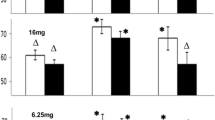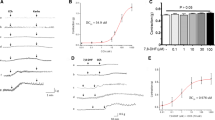Abstract
The muscarinic receptor antagonist propiverine used for therapy of overactive bladder undergoes first pass metabolism, leading to several active metabolites, which affect muscarinic receptors and L-type Ca2+ channels with different potencies. M-5, the major metabolite in blood, and M-6 can be synthesized as cis- and trans-isomers. We systematically investigated the pharmacodynamic profiles of the isomers on detrusor contractile function. In murine and porcine detrusor, the effects of the derivatives were examined on contractions induced by electric field stimulation (EFS), cumulatively increasing concentrations of carbachol or high KCl concentration. EFS contractions were concentration-dependently reduced by the M-5 and M-6 isomers although to a different extent. M-5 cis was slightly more potent than M-5 trans , but the differences did not reach statistical significance. M-6 cis was significantly more potent than M-6 trans . Responses to carbachol were antagonized by all compounds due to rightward shifts of the concentration–response curves, but only M-5 trans also significantly reduced the maximum response. pK B values obtained with Schild plot analysis indicated slightly higher potency for M-6 cis than M-6 trans . Ca2+ influx-dependent contractions elicited by K+ depolarization were less impaired by low concentrations of the M-6 isomers, but strongly suppressed by 100 µM of the M-5 isomers, suggesting an additional effect of the two M-5 isomers on Ca2+ influx. All investigated isomers of M-5 and M-6 are biologically active in reducing detrusor contraction in animal tissue. While M-5cis, M-6 cis , and M-6 trans possess surmountable or partially surmountable antagonistic properties at muscarinic receptors, M-5 trans is a strong non-competitive antagonist. However, at higher concentration ranges, all four compounds seem to have additional effects on Ca2+ influx.






Similar content being viewed by others
References
Abrams P (2003) Describing bladder storage function: overactive bladder syndrome and detrusor overactivity. Urology 62:28–37, discussion 40-22
Abrams P (2005) Urgency: the key to defining the overactive bladder. BJU Int 96(Suppl 1):1–3
Abrams P, Andersson KE (2007) Muscarinic receptor antagonists for overactive bladder. BJU Int 100:987–1006
Abrams P, Andersson KE, Buccafusco JJ, Chapple C, de Groat WC, Fryer AD, Kay G, Laties A, Nathanson NM, Pasricha PJ, Wein AJ (2006) Muscarinic receptors: their distribution and function in body systems, and the implications for treating overactive bladder. Br J Pharmacol 148:565–578
Andersson KE, Arner A (2004) Urinary bladder contraction and relaxation: physiology and pathophysiology. Physiol Rev 84:935–986
Andersson KE, Persson K (1993) The L-arginine/nitric oxide pathway and non-adrenergic, non-cholinergic relaxation of the lower urinary tract. Gen Pharmacol 24:833–839
Bayliss M, Wu C, Newgreen D, Mundy AR, Fry CH (1999) A quantitative study of atropine-resistant contractile responses in human detrusor smooth muscle, from stable, unstable and obstructed bladders. J Urol 162:1833–1839
Fetscher C, Fleichman M, Schmidt M, Krege S, Michel MC (2002) M(3) muscarinic receptors mediate contraction of human urinary bladder. Br J Pharmacol 136:641–643
Frei E, Hofmann F, Wegener JW (2009) Phospholipase C mediated Ca2+ signals in murine urinary bladder smooth muscle. Eur J Pharmacol 610:106–109
Fry CH, Skennerton D, Wood D, Wu C (2002) The cellular basis of contraction in human detrusor smooth muscle from patients with stable and unstable bladders. Urology 59:3–12
Giglio D, Tobin G (2009) Muscarinic receptor subtypes in the lower urinary tract. Pharmacology 83:259–269
Hegde SS (2006) Muscarinic receptors in the bladder: from basic research to therapeutics. Br J Pharmacol 147(Suppl 2):S80–S87
Madersbacher H, Mürtz G (2001) Efficacy, tolerability and safety profile of propiverine in the treatment of the overactive bladder (non-neurogenic and neurogenic). World J Urol 19:324–335
Maruyama S, Oki T, Otsuka A, Shinbo H, Ozono S, Kageyama S, Mikami Y, Araki I, Takeda M, Masuyama K, Yamada S (2006) Human muscarinic receptor binding characteristics of antimuscarinic agents to treat overactive bladder. J Urol 175:365–369
May K, Westphal K, Giessmann T, Wegner D, Adam U, Lerch MM, Oertel R, Warzok RW, Weitschies W, Braeter M, Siegmund W (2008) Disposition and antimuscarinic effects of the urinary bladder spasmolytics propiverine: influence of dosage forms and circadian-time rhythms. J Clin Pharmacol 48:570–579
Michel MC, Hegde SS (2006) Treatment of the overactive bladder syndrome with muscarinic receptor antagonists: a matter of metabolites? Naunyn Schmiedebergs Arch Pharmacol 374:79–85
Ouslander JG (2004) Management of overactive bladder. N Engl J Med 350:786–799
Pessina F, Marazova K, Kalfin R, Sgaragli G, Manganelli A, Milenov K (2001) Mechanical response to electrical field stimulation of rat, guinea-pig, monkey and human detrusor muscle: a comparative study. Naunyn Schmiedebergs Arch Pharmacol 363:543–550
Rivera L, Brading AF (2006) The role of Ca2+ influx and intracellular Ca2+ release in the muscarinic-mediated contraction of mammalian urinary bladder smooth muscle. BJU Int 98:868–875
Schneider T, Fetscher C, Krege S, Michel MC (2004) Signal transduction underlying carbachol-induced contraction of human urinary bladder. J Pharmacol Exp Ther 309:1148–1153
Sibley GN (1984) A comparison of spontaneous and nerve-mediated activity in bladder muscle from man, pig and rabbit. J Physiol 354:431–443
Siegmund W, Nigussie M, Tilahun K, Aitenfissu H, Franke G, Wengler A (1990) Anticholinergic properties of propiverine and its metabolites. Pharmazie 45:67–68
Siepmann M, Nokhodian A, Thummler D, Kirch W (1998) Pharmacokinetics and safety of propiverine in patients with fatty liver disease. Eur J Clin Pharmacol 54:767–771
Stevens LA, Chapple CR, Chess-Williams R (2007) Human idiopathic and neurogenic overactive bladders and the role of M2 muscarinic receptors in contraction. Eur Urol 52:531–538
Sugiyama Y, Yoshida M, Masunaga K, Satoji Y, Maeda Y, Nagata T, Inadome A, Ueda S (2008) Pharmacological effects of propiverine and its active metabolite, M-1, on isolated human urinary bladder smooth muscle, and on bladder contraction in rats. Int J Urol 15:76–81
Uchida S, Kurosawa S, Fujino Oki T, Kato Y, Nanri M, Yoshida K, Yamada S (2007) Binding activities by propiverine and its N-oxide metabolites of L-type calcium channel antagonist receptors in the rat bladder and brain. Life Sci 80:2454–2460
Wegener JW, Schulla V, Lee TS, Koller A, Feil S, Feil R, Kleppisch T, Klugbauer N, Moosmang S, Welling A, Hofmann F (2004) An essential role of Cav1.2 L-type calcium channel for urinary bladder function. FASEB J 18:1159–1161
Wuest M, Braeter M, Schoeberl C, Ravens U (2005a) Juvenile pig detrusor: effects of propiverine and three of its metabolites. Eur J Pharmacol 524:145–148
Wuest M, Hecht J, Christ T, Braeter M, Schoeberl C, Hakenberg OW, Wirth MP, Ravens U (2005b) Pharmacodynamics of propiverine and three of its main metabolites on detrusor contraction. Br J Pharmacol 145:608–619
Wuest M, Hiller N, Braeter M, Hakenberg OW, Wirth MP, Ravens U (2007) Contribution of Ca2+ influx to carbachol-induced detrusor contraction is different in human urinary bladder compared to pig and mouse. Eur J Pharmacol 565:180–189
Wuest M, Weiss A, Waelbroeck M, Braeter M, Kelly LU, Hakenberg OW, Ravens U (2006) Propiverine and metabolites: differences in binding to muscarinic receptors and in functional models of detrusor contraction. Naunyn Schmiedebergs Arch Pharmacol 374:87–97
Wüst M, Averbeck B, Reif S, Bräter M, Ravens U (2002) Different responses to drugs against overactive bladder in detrusor muscle of pig, guinea pig and mouse. Eur J Pharmacol 454:59–69
Yono M, Yoshida M, Wada Y, Kikukawa H, Takahashi W, Inadome A, Seshita H, Ueda S (1999) Pharmacological effects of tolterodine on human isolated urinary bladder. Eur J Pharmacol 368:223–230
Zhu HL, Brain KL, Aishima M, Shibata A, Young JS, Sueishi K, Teramoto N (2008) Actions of two main metabolites of propiverine (M-1 and M-2) on voltage-dependent L-type Ca2+ currents and Ca2+ transients in murine urinary bladder myocytes. J Pharmacol Exp Ther 324:118–127
Acknowledgments
We thank Maria Feilmeier and Sabine Kirsch for their excellent technical help.
Author information
Authors and Affiliations
Corresponding author
Rights and permissions
About this article
Cite this article
Propping, S., Braeter, M., Grimm, MO. et al. Anticholinergic effects of cis- and trans-isomers of two metabolites of propiverine. Naunyn-Schmied Arch Pharmacol 381, 329–338 (2010). https://doi.org/10.1007/s00210-010-0493-x
Received:
Accepted:
Published:
Issue Date:
DOI: https://doi.org/10.1007/s00210-010-0493-x




